
A bogie is a chassis or framework that carries a wheelset, attached to a vehicle—a modular subassembly of wheels and axles. Bogies take various forms in various modes of transport. A bogie may remain normally attached or be quickly detachable. It may include a suspension component within it, or be solid and in turn be suspended ; it may be mounted on a swivel, as traditionally on a railway carriage or locomotive, additionally jointed and sprung, or held in place by other means.

A cart or dray is a vehicle designed for transport, using two wheels and normally pulled by draught animals such as horses, donkeys, mules and oxen, or even smaller animals such as goats or large dogs.

A single-track vehicle is a vehicle that leaves a single ground track as it moves forward. Single-track vehicles usually have little or no lateral stability when stationary but develop it when moving forward or controlled. In the case of wheeled vehicles, the front and rear wheel usually follow slightly different paths when turning or when out of alignment.

A wagon or waggon is a heavy four-wheeled vehicle pulled by draught animals or on occasion by humans, used for transporting goods, commodities, agricultural materials, supplies and sometimes people.
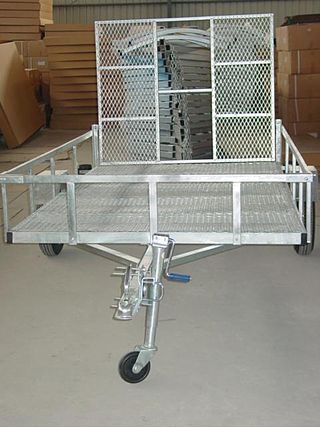
A trailer is an unpowered vehicle towed by a powered vehicle. It is commonly used for the transport of goods and materials.

A velocipede is a human-powered land vehicle with one or more wheels. The most common type of velocipede today is the bicycle.

A drive shaft, driveshaft, driving shaft, tailshaft, propeller shaft, or Cardan shaft is a component for transmitting mechanical power and torque and rotation, usually used to connect other components of a drivetrain that cannot be connected directly because of distance or the need to allow for relative movement between them.

A draisine is a light auxiliary rail vehicle, driven by service personnel or own user, equipped to transport crew and material necessary for the maintenance of railway infrastructure. This includes leisure, driven by the own user, in a safe way.

A monowheel or uniwheel is a type of one-wheeled, single-track vehicle. Unlike the unicycle, a monowheel consists of a large, hollow wheel that loops above and around the driver. Monowheels are typically powered by an engine as with a motorcycle, with a chassis securing the steering, driver's seat, and propulsion mechanism to the interior of the wheel.
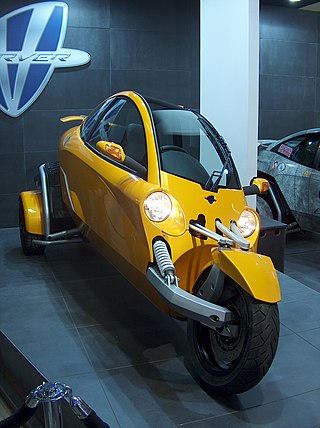
A tilting three-wheeler, tilting trike, leaning trike, or even just tilter, is a three-wheeled vehicle and usually a narrow-track vehicle whose body and or wheels tilt in the direction of a turn. Such vehicles can corner without rolling over despite having a narrow axle track because they can balance some or all of the roll moment caused by centripetal acceleration with an opposite roll moment caused by gravity, as bicycles and motorcycles do. This also reduces the lateral acceleration experienced by the rider, which some find more comfortable than the alternative. The narrow profile can result in reduced aerodynamic drag and increased fuel efficiency. These types of vehicles have also been described as "man-wide vehicles" (MWV).

A bicycle trailer is a motorless wheeled frame with a hitch system for transporting cargo by bicycle. It can greatly increase a bike's cargo capacity, allowing point-to-point haulage of objects up to 3 cubic metres in volume that weigh as much as 500 kg. However, very heavily loaded trailers may pose a danger to the cyclist and others, and the voluntary European standard EN 15918 therefore suggests a maximum load of 60 kg on trailers without brakes.

A horse-drawn vehicle is a piece of equipment pulled by one or more horses. These vehicles typically have two or four wheels and were used to carry passengers or a load. They were once common worldwide, but they have mostly been replaced by automobiles and other forms of self-propelled transport but are still in use today.
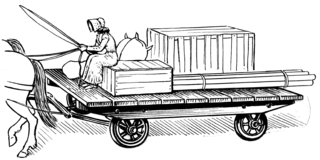
Among horse-drawn vehicles, a lorry was a low-loading trolley. It was used mainly for the carriage of other vehicles, for example for delivery from the coachbuilders or returning there for repair.
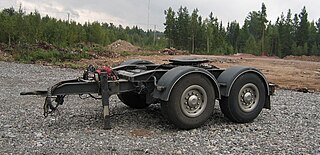
A dolly is an unpowered vehicle designed for connection to a tractor unit, truck or prime mover vehicle with strong traction power.
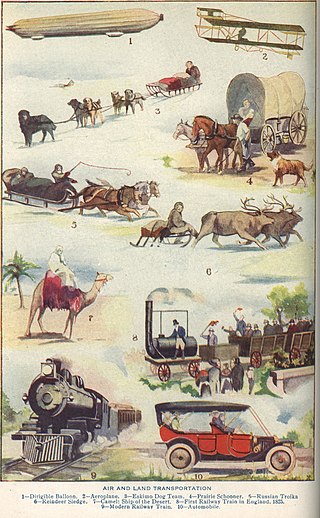
The following outline is provided as an overview of and topical guide to transport:

A dicycle is a vehicle with two parallel wheels, side by side, unlike single-track vehicles such as motorcycles and bicycles, which have two wheels inline. Originally used to refer to devices with large wheels and pedals, the term is now used in relation to powered self-balancing scooters with smaller wheels and no pedals such as the Segway PT and the self-balancing hoverboard.

The following outline is provided as an overview of and topical guide to bicycles:

Human-powered land vehicles are land vehicles propelled over ground by human power, The main ways to support the weight of a human-powered land vehicle and its contents above the ground are rolling contact; sliding contact; intermittent contact; no contact at all as with anything carried; or some combination of the above. The main methods of using human power to propel a land vehicle are some kind of drivetrain; pushing laterally against the ground with a wheel, skate, or ski that simultaneously moves forward; by pushing against the ground directly with an appendage opposite to the direction of travel; or by propeller. Human-powered land vehicles can be propelled by persons riding in the vehicle or by persons walking or running and not supported by the vehicle.



















